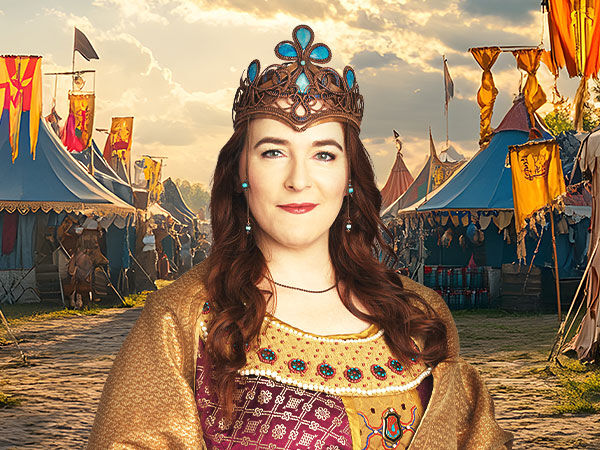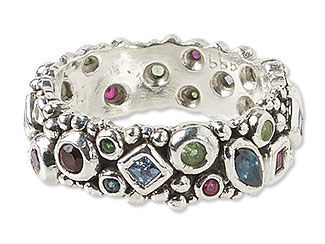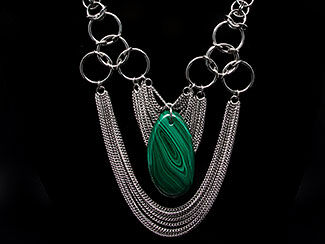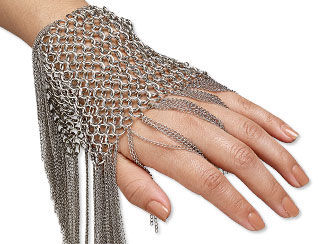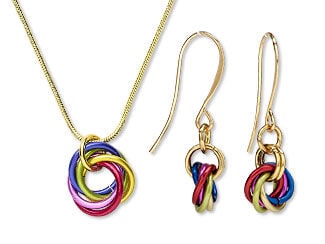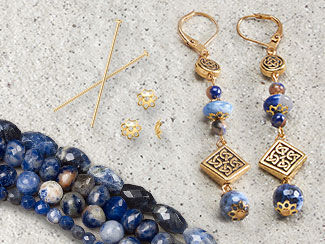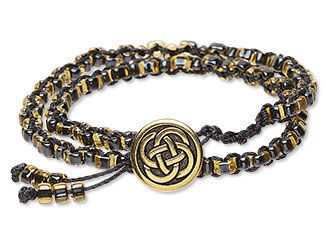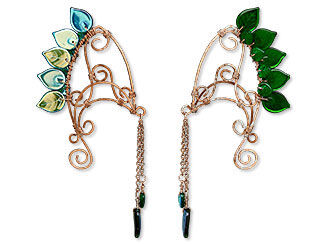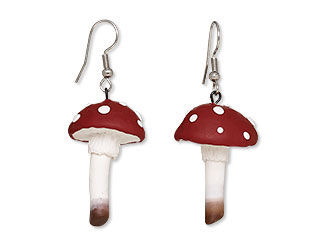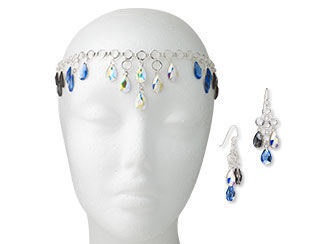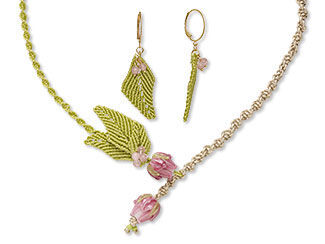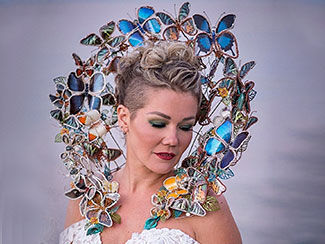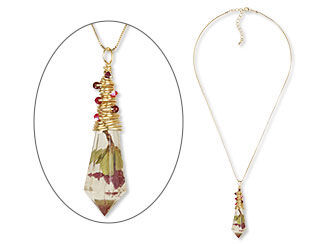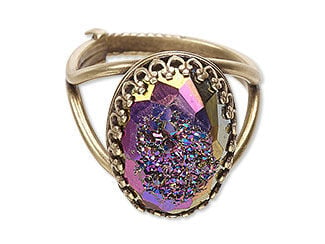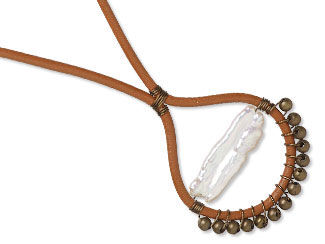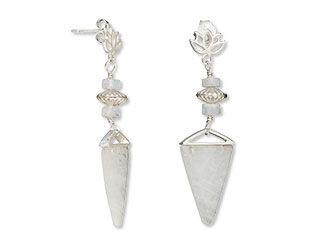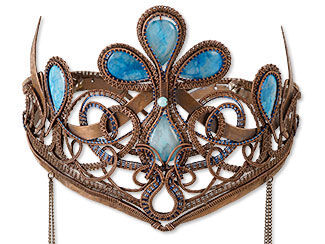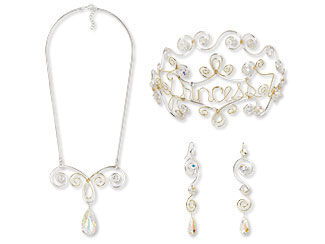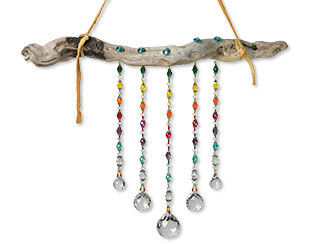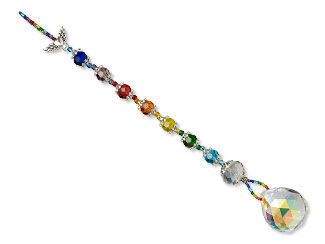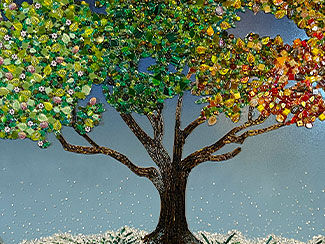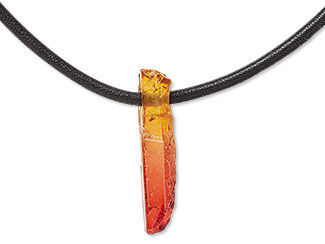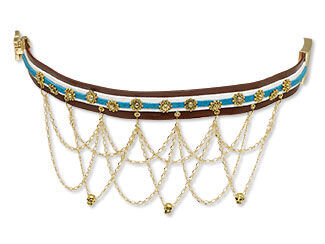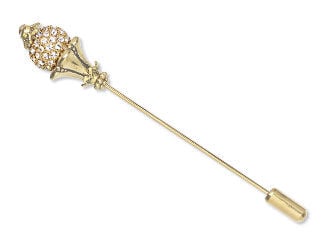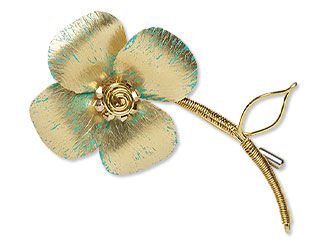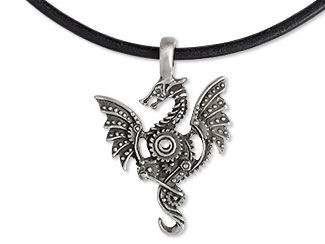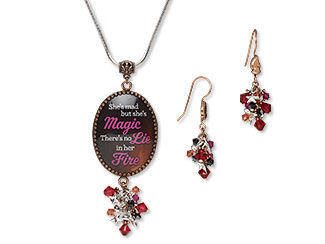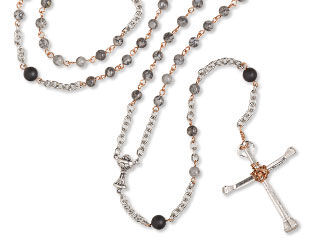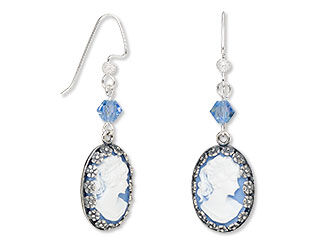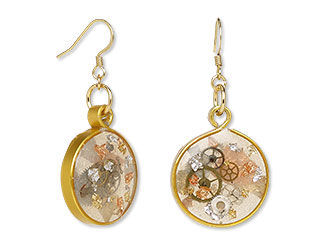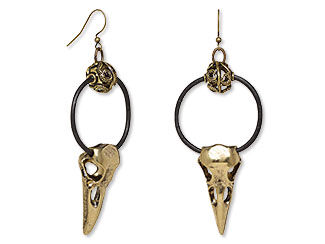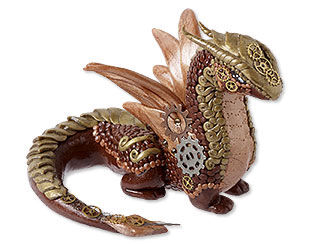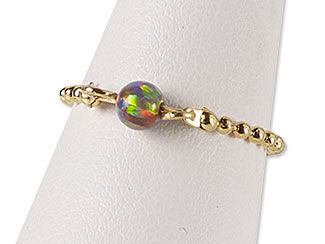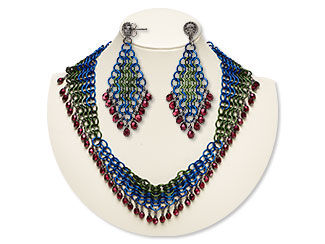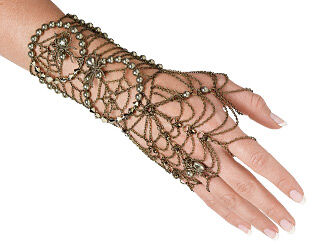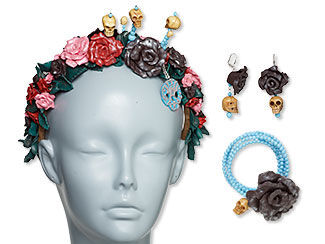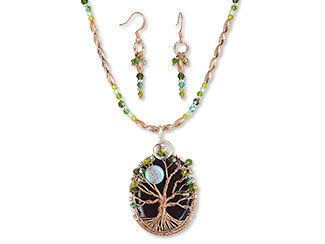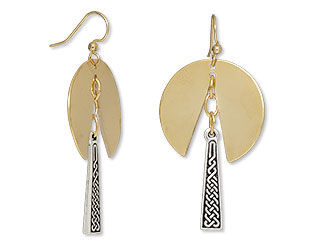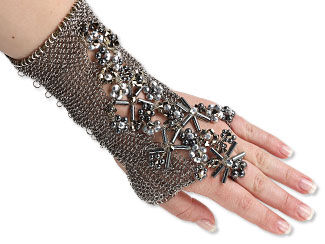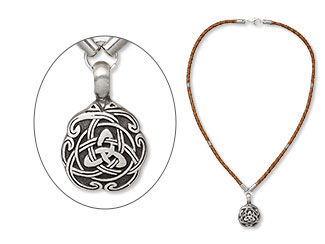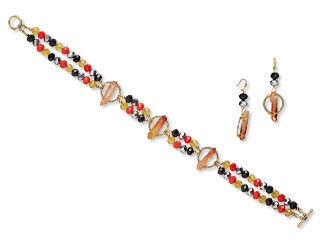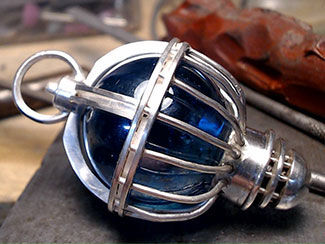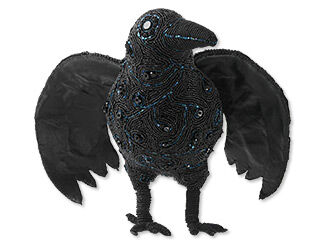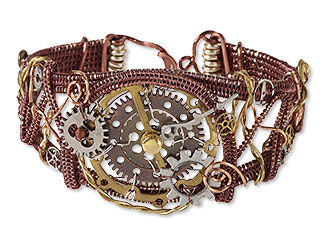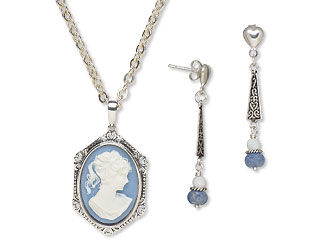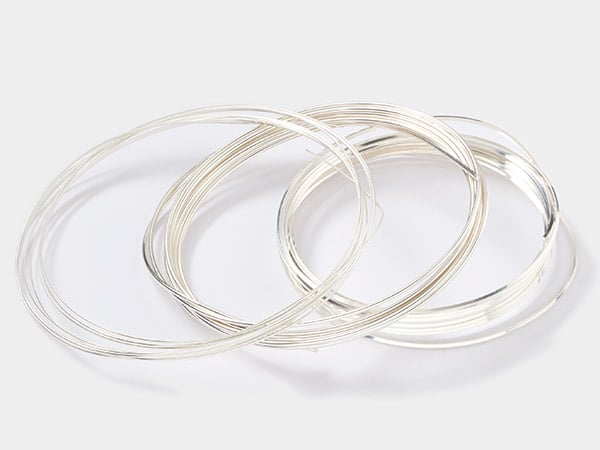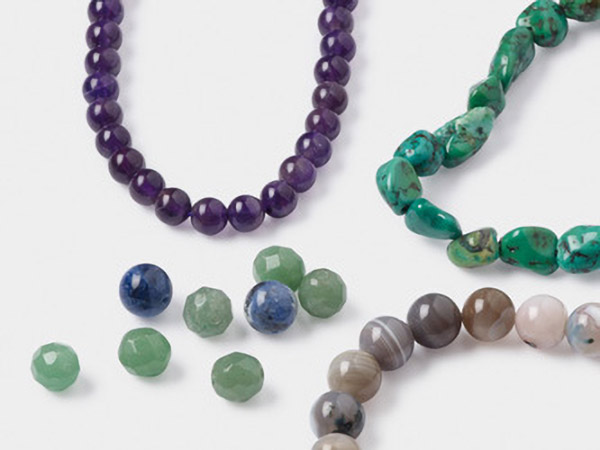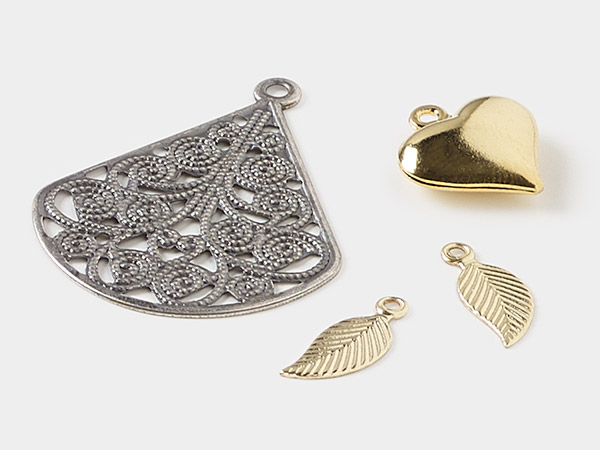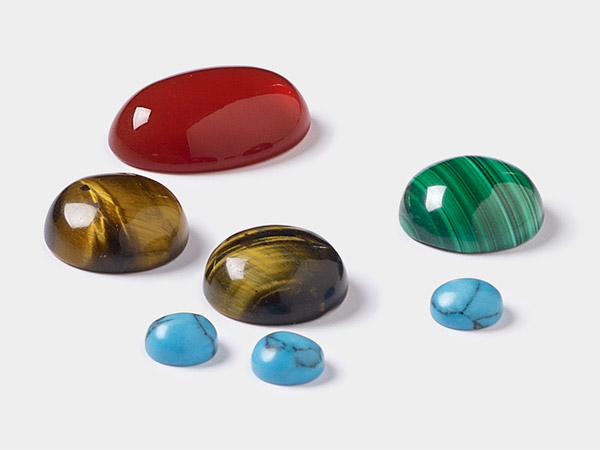Geek Chic Jewelry: Part 7 – Ren Faire Jewelry and Accessories
by Brandy Bruder, Design Idea K129
A Ren Faire (or Renaissance Festival) is an outdoor event that attempts to recreate the look and feel of Europe in the mid-1500s to early 1600s. A majority of Ren Faires set themselves in England during the time of Shakespeare and usually have paid performers acting out the roles of historical figures from that time such as Queen Elizabeth I and Mary, Queen of Scots.
Ren Faires tend to attract three interest groups: history, fantasy and entertainment. The history customers are looking for an immersive experience and want their purchases to evoke that history for them, as authentically as possible. The fantasy customers attend for the sense of wonder and creativity, often seeking playful items that let them feel that magic back in their everyday lives. The entertainment crowd has come for the fun of it, to see the sights and take home a reminder of a really great day.
Tap into these markets by creating what appeals to them, offering a range of price points and determining how best to get your creations into their hands.
Know Your Faire
Getting a booth at a Faire can be hard, as some Faires have a waiting list of interested vendors. Others will jury what their vendors sell, to make sure what is being sold fits the theme and aesthetic of the event. Rules about what visitors can wear, what cast members can wear and what vendors can sell are rarely identical and can vary from Faire to Faire.
Most Faires try to have a well-balanced variety of product categories available: leatherwork, clothing, home décor, jewelry (of course) and others. Most events avoid having too many booths in the same category. So take a look at the event’s website and see if it’s currently accepting vendors in categories you create in, before sending in any applications. One Faire was only accepting vendors in the fine arts category—all their other categories were full and had long waiting lists!
Experienced Faire merchants had these suggestions for any artist who wants to sell their work:
- Visit your closest Faire and see what’s selling. New vendors need to offer products that are noticeably different from what current vendors already have.
- Work for a couple of current vendors at different Faires, to get a feeling for the selling side of the event and meet people in the organization who can increase your chance of success.
- Check the laws and regulations for where you live. Then check the laws and regulations for where you’re selling, especially if it’s in a different state, county or city than the one you live in.
Choose Your Category and Medium
Individual Ren Faires often have different expectations for matching the theme and atmosphere of the event. While some Faires are sticklers for historically inspired handcrafted pieces, others are more open to booths reselling commercial designs with fantasy or steampunk elements. Whatever you sell, make sure the signs clearly identify pieces you make and items you might be reselling.
Jewelry and accessories can be a crowded category on the Ren Faire circuit, so making a niche for yourself and having a range of styles, sizes and price points is crucial to success. Depending on the Faire, Victorian-style steampunk cameo brooches could be completely forbidden or the best-selling product.
So here are some jewelry and accessory types that would fit right in at a Renaissance Faire:
- Chainmaille and Scalemaille
These are bracelets, necklaces, anklets, earrings—even headpieces—made with tiny metal rings, discs or scales woven together. Maille pieces can be in traditional metal colors or showcasing bright rainbow finishes.
- Celtic
Customers often enjoy pieces embellished with interlaced (knotwork) or tree of life designs, triskeles, claddaghs, daffodils, shamrocks and thistles. Some month-long Faires host themed weekends, so check individual schedules.
- Fantasy-Inspired
Graceful wirework elven styles, airy and delicate polymer clay fairy creations, fierce seed beaded dragons, colorful resin mermaid fashions and other ideas drawn from fiction, folk tales and mythology are popular. Some Faires lean towards historical elements over fantastical ones, so expect rules to vary from event to event.
- Gemstone
Gemstones have aesthetic as well as metaphysical appeal for a variety of Faire-goers. You can offer rings, pendants, bracelets and earrings featuring rough, glossy or druzy gemstone components in popular materials such as amethyst, garnet, quartz crystal and amber.
- Headwear
Crowns, circlets and tiaras suit customers who want to play royalty for the day, while embellished hats and other headwear will complete the look for other Faire visitors. With crowns, be sure to review any Faire rules to ensure customers don’t look like they’re one of the paid performers.
- Home Décor
Not everyone wants to wear their souvenirs, so offering décor options lets you expand your audience. Consider wine charm sets, bottle stoppers, gemstone trees, polymer clay sculptures, suncatchers, beaded picture frames, candle holders, embellished vases and bowls, napkin holders, wind chimes and other categories.
- Organic Materials
Expand product offerings with natural organic materials such as leather, bone, horn, shell, linen, silk, hemp and more. Jewelry and accessory designs made with organic materials allow for a wide range of styles, from natural tones to brightly dyed pieces. Often featuring knotting techniques, studs, metal accents, runes or other symbols, many of these styles can be created as unisex or masculine for wider audience appeal.
- Pins and Brooches
Medieval people used pins more than buttons, so this is a fantastic category to offer Faire-goers. Pins and brooches can feature gemstone cabochons, sea glass, cameos and coats of arms; nature-centered images such as leaves, flowers, berries, jellyfish, octopi and dragonflies; or even fantastical designs like elves, fairies, unicorns and mermaids. Some Faires lean towards historical elements over fantastical ones, so expect rules to vary from event to event.
- Talismans and Amulets
Think rings, necklaces, bracelets and pendants featuring medieval themes and images like castles, swords, shields and mythical creatures that were real to medieval people (such as griffins, dragons and unicorns). Consider including crosses, rosaries and paternosters, as the medieval world often had a religion-centered view of life.
- Victorian, Gothic, Goblincore and Steampunk
Create cameos, brooches, lockets, gears and other metal pieces with antique or verdigris finishes and adorned with intricate patterns, plus crosses, skulls and gemstones in dark, saturated colors. Some Faires focus on only medieval and Renaissance elements and avoid other time periods, so expect rules to vary from event to event.
Be Prepared to Sell – Space, Engagement, Pricing and More
Renaissance Faire attendees come prepared to spend money, often saving their funds over the year to make sure they have enough for whatever catches their eye. To sell to Faire-goers, you need a space to sell from, engagement with visitors, a range of price options and multiple payment options.
Space
What space you sell from will need to meet the individual Faire’s rules and guidelines. Some Faires have a “group booth” on offer, where you can buy into a shared booth for your first year to see how your creations do. Other Faires let new vendors put up a pop-up booth for a weekend, but require a more appropriate set-up for a full season. And some are sticklers for historical accuracy from the get-go, meaning you’ll need a canvas tent to begin at all. Each event is different, so check each Faire’s website or vendor packet.
Once you have a space (booth or tent), then you can make choices for setting up shop! Renaissance Faire attendees are often drawn to displays that immerse them in the event’s atmosphere, concealing modern-day elements as much as possible. Here are a few ways to transform your space into an eye-catching, head-turning experience:
- Decoration
Medieval doesn’t mean plain. Medieval people loved color and had all kinds of dyes and paints that made their world beautiful. Cover tables with fabrics that suit your brand, like velvet for high-end jewelry or burlap for rustic décor items. Add tapestries or banners, place low-nap area rugs across the floor and use wood or wrought-iron props to give your space a more authentic look. - Presentation
Medieval doesn’t mean boring. Mannequins, busts and hand displays dressed with medieval-style costumes will showcase jewelry and accessories in context, helping customers visualize how your pieces would look on them. Include mirrors, of whatever size is necessary for buyers to see themselves in your art, to encourage purchasing. And don’t forget your packaging! Make sure your boxes, bags or pouches suit your brand and the Faire atmosphere. - Organization
Medieval doesn’t mean messy. Group similar items together from the beginning and make sure to tidy up during any lulls in foot traffic. It also helps you keep track of inventory as you go, ensuring no design or product gets pushed off to the side and overlooked by visitors. - Elbow Room
Medieval doesn’t mean cramped. Faires are open to a variety of people, including folks with mobility, vision and auditory aids. Make sure that your printed descriptions, care information, pricing and material lists are large, high contrast and easy to read. - Light
Medieval also doesn’t mean dark. Faires often run into the evening, so bring battery-operated lanterns or strings of lights. Most Faires do not allow fire on site, due to dry summertime conditions and tight quarters, so electric candles with digital “flames” will give your space a cozy atmosphere that will entice customers while the sun goes down.
Engagement
Customer interaction is key to selling at Renaissance Faires. Visitors and guests come to be immersed in the atmosphere, getting away from their everyday cares for a while. Interacting with you is part of that experience. Not engaging with customers in a Faire-appropriate way can lose you business and give you a reputation that means you won’t be allowed back.
- Mind your language
Vendors are usually not held to the same standards for historical language as paid staff. But attempting a few Faire-specific phrases will make you more appealing to potential customers by not breaking their illusion. Try greeting people with phrases like “Good morrow!” or “Hail, traveler!” to set the tone and let customers know you’re there to help. This friendly, enthusiastic approach makes your space more inviting, which often leads to sales. - Tell your story
If a creation has a special backstory—such as a pendant inspired by a historical artifact or a gemstone linked to medieval lore—share it! You can do that with printed materials near the design, or offer it verbally (especially if you’re a good storyteller). This can deepen the customer's connection to the piece, and they’ll remember you and your pieces even when the Faire is over. - Show your skills
If you have the space, set up a small work area where you can demonstrate your craft. This not only draws attention to your booth but also educates customers about the tools, skills and artistry involved. This is especially helpful when you use traditional techniques or methods to create your designs. Seeing how it’s made and the skillset needed to make it will often help support your pricing structure in ways customers understand and value. - Give them tools
Customer engagement begins in your Ren Faire shop—but it doesn’t end with the Faire. Give your customers and potential customers the tools they need to buy your work even when the event is over. You can hand out business cards, put up a sign or discreet QR code near your checkout area that links to your website, social media and/or mailing list. Make it easy for them to see your upcoming selling schedule, contact you for custom orders or see your latest designs.
Faire Pricing
Faire-goers are financially and psychologically prepared to spend money and many will plan all year to make significant purchases while attending. So pricing your work effectively is important for maximizing sales. Here's one way to approach it:
- Offer a range
Showcase a few dramatic show-stopper pieces—those higher-end creations with intricate designs and/or expensive materials—for well-heeled attendees. Balance these with smaller, simpler options, in quantity, so customers at every economic level can find something they love in your space. In modern business, this is called The Lipstick Effect, and it’s an effective selling technique around the world. - List your materials
Let customers know about the work that goes into your pieces, whether it's hand-forged metals, sophisticated wire-wrapping, manually polished gemstones, intricate off-loom seed beading and more. Highlighting your craftsmanship, focus on details and attention to authenticity can help explain higher prices on specific designs. - Let them see
There’s a reason clothing stores have changing rooms/fitting rooms: people want to try stuff on before they buy. Ren Faire guests love getting into character, so encourage them to try on what you’ve made and look at themselves in your mirrors. Seeing how your design meshes with the rest of their outfit can increase the likelihood of a sale. - Build some bundles
When you have a range of price points, you can build discounted bundles to drive sales and move profitable traffic through your space. BOGO (Buy One, Get One) on stretch bracelets or scatter pins can encourage impulse buys while enticing potential customers into your shop to discover—and purchase—your high-end show-stopper designs. - Prepare some promotions
Depending on your status as a vendor, you can create different promotions for your shop. If you’re selling for only a day, put up a One Day Only sign on your work. If you’ll be there the whole time, create World’s End Sale on the last day of the Faire. Use that discreet QR code near your checkout area to offer a discount for their next purchase if they sign up for your newsletter or mailing list.
Count Cash, Master Card and M’lady Visa
Renaissance Faires give the appearance of being low-tech environments, but often have a modern infrastructure behind them. Multiple payment options are expected. Here's how to make purchasing as easy as possible for customers:
- Paying in coin
While cash is always acceptable, people are carrying less and less physical money (pickpockets are modernly common as well as historically accurate). Make sure you have appropriate change for customers using cash—including the addition of sales tax! - Mobile payment options
Make sure to have a reliable mobile payment solution, such as a Square reader, to accommodate customers who may not carry cash. Letting customers know you accept cards can prevent missed sales. A handy sign is all it takes. Check with the event to see what their mobile coverage is on site; some places have too many trees for reliable cell service.
After the Faire
At the Faire, you gave customers and potential customers ways to contact you and see your creations even after everyone’s gone home. Ren Faires build loyal patrons, who return year after year after year—many even saved their money during the Covid-19 shut downs to buy from their favorite artists online. After the Faire is the time you check those accounts, build your side of these relationships and connect with Faire-goers to let them know you’re actively making and selling your art.
- Turn on your online shopping site(s)
Since these can range from Folksy, Etsy and Drifa’s Leap to Depop, Vinted, Not On The High Street and more, you’ll need to determine which marketplace suits your needs best. If you share inventory between your booth and your online site, turn the site off while you’re at Faire and turn it back on when you get home and have taken inventory. - Show up on social media
Whether you’re on Facebook, Instagram, Pinterest, WhatsApp Business, Telegram, TikTok, Snapchat, Reddit, LinkedIn, Quora, Discord, Tumblr, Bluesky or anything else, be active! Different demographics favor different platforms, so knowing your audience is vital.
This is where you can put up a few pics of the Faire, upload images of your work, share behind-the-scenes glimpses of your creative process and update your list of upcoming events. You can also reward customer loyalty through your social media account(s), with special discounts or Faire-time freebies for repeat customers and social media followers.
And finally, don’t forget your fellow vendors/merchants! Building relationships with other sellers can expand your opportunities and skill sets. This is where you’ll hear about new Faires starting, collect tips to follow or things to avoid at particular locations, get offers for artistic collaborations that can bring your artistry to a different audience and even recommendations to your designs when their customers are looking for a “good place” to buy something you make.
Ren Faires are a blend of history and fantasy that attract crowds of visitors every year—and those visitors crave unique, handcrafted souvenirs of their time at the Faire. Artisans who create themed jewelry, accessories and décor items with historical, mythological or fantastical elements can do very well when selling to the Ren Faire crowd.
And finally, a lot of styles that sell at Ren Faires also do well in similar markets: science fiction and comic conventions, geeky craft bazaars, steampunk gatherings, Society for Creative Anachronism (SCA) events, etc. And if your historical designs doesn’t fit medieval or Renaissance themes, don’t worry! All around the world, there are other events similar to Ren Faires that cover different times and places, including Colonial America, the Age of Piracy, Regency England, ancient Rome, the US Civil War, the English Civil War, the Viking Age and more.
Shop for Your Materials Here:
Have a question regarding this project? Email Customer Service.
Copyright Permissions
All works of authorship (articles, videos, tutorials and other creative works) are from the Fire Mountain Gems and Beads® Collection, and permission to copy is granted for non-commercial educational purposes only. All other reproduction requires written permission. For more information, please email copyrightpermission@firemtn.com.
